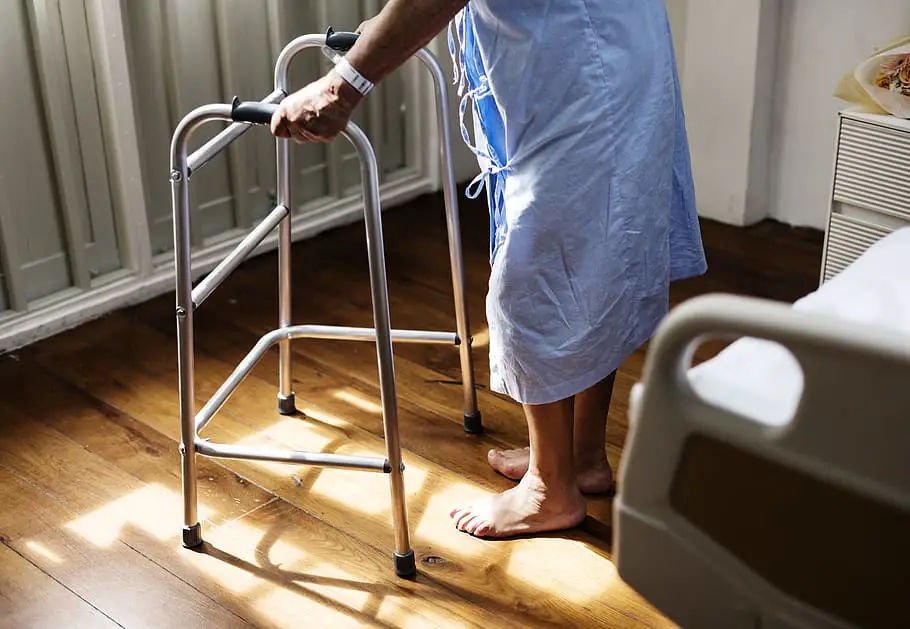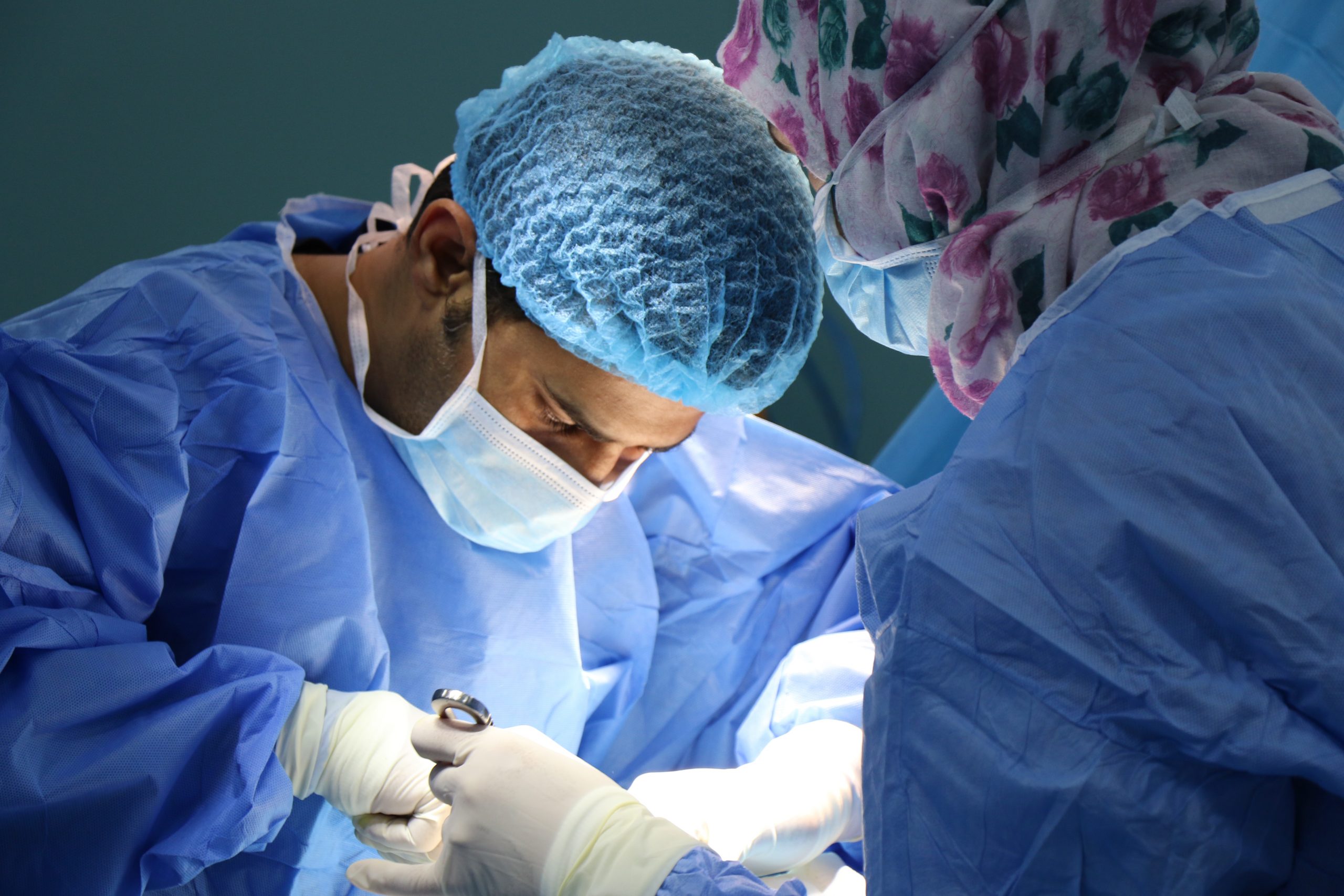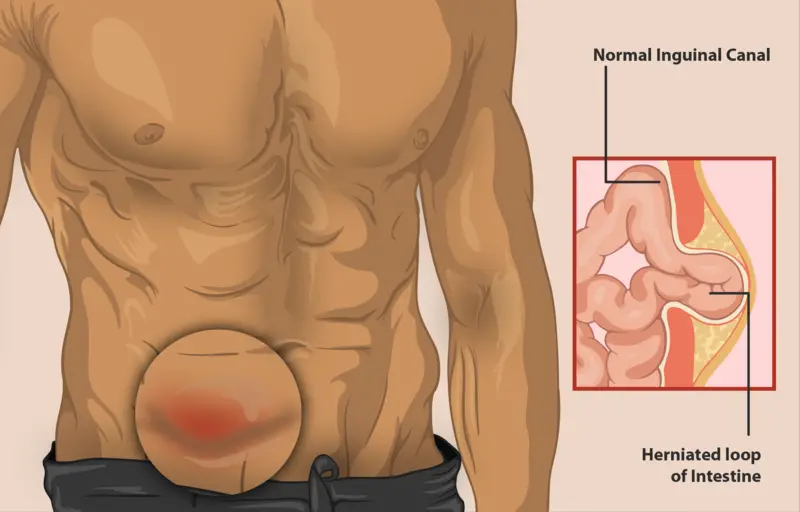Your doctor has diagnosed you with inguinal hernia for which he recommended surgical treatment? So you are probably asking yourself a lot of questions, especially about the course of your recovery period after surgery.
In this article, we will give you some information on what awaits you concretely once the intervention has been carried out. This will allow you to be better prepared and you will be able to go through this delicate period with more serenity.
Inguinal hernia: ddefinition and brief anatomical reminder
La inguinal region is the part of the body located between the abdomen and the thigh. Many important anatomical structures pass through this region, including the inguinal ligament and iliac blood vessels which give rise to the vascular elements of the inner limb (femoral vessels).
This region is also crossed by the round ligament of the uterus in women, and by the spermatic cord containing the vas deferens (duct that carries sperm from the testicle to the urethra) and the vessels and nerves of the testicle in men.
We are talking about inguinal hernia when part of the abdominal viscera (small intestine, colon, etc.) passes through an orifice in the inguinal region (area of weakness).
It then forms a small ball under the skin at the level of the groin. This is generally painless et coughing impulsively (appears or increases in volume during coughing or any other maneuver increasing intra-abdominal pressure).
The inguinal hernia can be congenital or acquired, direct or indirect, benign or strangulated… To know everything about the inguinal hernia, Appointment here.
Surgical treatment of inguinal hernia
In many cases, the inguinal hernia remains asymptomatic. She is not neither painful nor bothersome. It is then discovered in such a way fortuitous during a medical visit for another reason and does not require emergency surgery.
On the other hand, when the inguinal hernia is (or becomes) bulky, painful or takes on a purplish-blue colour, it is imperative to carry out a surgical cure as soon as possible.
Indeed, these signs could indicate a strangulation elements contained in the hernial sac. Deprived of blood and oxygen, the latter can become necrotic in a few hours in the absence of intervention.
This is why it is recommended to treat the inguinal hernia before reaching the stage of strangulated hernia. This allows serene care and limits complications.
Le surgical treatment of the inguinal hernia consists of making an incision at the level of the seat of the hernia, emptying its contents by putting the various elements back in their place (in the abdominal cavity), closing the hernial orifice using sutures and finally closing the incision surgical.
There are many surgical techniques to treat an inguinal hernia. Some of them require general anesthesia, others can be performed under local or locoregional anesthesia (patient conscious during the procedure, but feeling no pain).
To discover the different operating techniques used in the surgical treatment of inguinal hernias, read our article which is specially dedicated to them
Inguinal hernia repair: abefore the intervention
That's it, the surgical indication is asked by your attending physician. The latter then directs you to a surgeon visceral (or general) so that the latter takes care of the intervention.
Initially, the surgeon will consult your medical file and re-examine you from head to toe in order to be aware of all the clinical elements that dismay you (personal medical and surgical history, family history, type of inguinal hernia, etc.).
Then, he will give you an appointment the day before the operation for a consultation with the anesthesiologist and to finalize details before D-Day (stay fasting, stop any drug treatment, give you some information on the course of the operation, etc.).
Inguinal hernia repair: after the procedure
After the procedure, your surgeon or one of his assistants will be with you when you wake up to ensure that there are no immediate postoperative complications such as:
- Postoperative hematoma: it is an accumulation of blood at the operating site, especially if you were on anticoagulant treatment or if you suffered from a hematological pathology making your blood fluid and difficult to clot (hemophilia). A gesture of surgical drainage will be performed to evacuate the hematoma only if the latter is large enough. Indeed, hematomas of small abundance will simply be monitored, as they generally regress spontaneously in a few days or weeks.
- The infection : the medical team will closely monitor your vital constants, in particular your thermal curve, in order to detect any postoperative infection.
- ischemic orchitis (in men): In rare cases, the vessels supplying the testicle may be affected. This causes a disturbance of the vascularization of the testicle on the operated side. This is manifested by an increase in volume of the latter as well as scrotal pain. This orchitis can be treated fairly well with anti-inflammatories and analgesics.
If all goes well, you will be allowed to eat light food on the evening of the procedure. In fact, intestinal transit generally resumes fairly quickly after this type of intervention (no heavy surgery such as an intestinal anastomosis or a resection, etc.).
You can also get up and marcher very early, about 4 to 6 hours after the procedure. Getting up early is very beneficial, because it effectively prevents the risks associated with prolonged bed rest, in particular thromboembolic complications (pulmonary embolism for example) and urinary tract infection.
The next day, you can be discharged from the hospital. You will therefore only be hospitalized approximately 48 to 72 hours, from the day before to the day after the operation. Your surgeon will give you an appointment after 15 to 30 days to ensure that the incision has healed properly and that there are no complications (recurrence, etc.).
Although you can quickly resume an almost normal socio-professional life, your doctor will prescribe a work stopping in order to recover more serenely.
The duration of this work stoppage varies according to the physical hardship of your profession and the complexity of the intervention carried out. In general, it is 15 days to a month.
During the first weeks following the operation, you will be able to gradually resume physical activity moderate like walking or climbing stairs. However, you will be recommended to avoid major efforts or the carrying of heavy loads, as this could cause the sutures to come loose and the inguinal hernia to recur.
It is not uncommon for pain persist after the intervention. Your doctor will prescribe analgesics or anti-inflammatories to relieve them while waiting for them to disappear over the days.
If they do not disappear after several weeks or increase in intensity, a specialist consultation will be necessary to determine the cause and treat it accordingly (neuropathic pain by nerve damage, for example).
For a full recovery after an inguinal hernia repair, it is necessary to count between 2 and 3 months. After this period, physical effort or intense sports can be resumed without risk. Obviously, nothing prevents developing a contralateral inguinal hernia (on the other side) or a recurrence on the same side.
Surgical treatment of an inguinal hernia: 10 key points to remember
Here are the main lines of the surgical treatment of inguinal hernia and its consequences:
- Note: emergency intervention in case of strangulated hernia, delayed in case of uncomplicated hernia.
- Duration of hospitalization: 48 to 72 hours, sometimes less. Generally, hospitalization extends from the day before the intervention until the day after it.
- Anesthesia: general anesthesia in case of classic intervention by laparotomy or laparoscopy.
- Duration of the intervention: very variable according to the complexity of the procedure, the type of hernia… It can range from about twenty minutes to 2 or 3 hours.
- Resumption of power supply: if the intervention is carried out in the morning, it is generally authorized to consume liquid or light food from the evening.
- Return to walking : early survey helps prevent postoperative thromboembolic and infectious complications. In general, walking is possible from 4 to 6 hours after the intervention.
- Pain: they are generally linked to tissue trauma caused at the operating site and disappear spontaneously with healing. In most cases, simple analgesics are enough to manage them effectively while waiting for their complete disappearance.
- Recovery: she is very fast. 2 or 3 weeks are enough to resume a normal socio-professional life. However, a work stoppage of 15 to 30 days is generally prescribed for a serene recovery.
- Healing time: it takes 2 to 3 months for complete healing. It will then be possible to resume intense physical or sporting activity without any problem.
- At the slightest problem: it is important to consult your doctor or your surgeon in the event of reappearance of the swelling, of a sudden resumption of pain, of appearance of a purplish coloring at the level of the operated site or any other problem in order to benefit from adequate support.
Projects
[1] P. Ananian, K. Barrau, P. Balandraud, and YP Le Treut, “Surgical treatment of inguinal hernias in adults: clinical, functional and economic issues of surgical practices”, Surgery Diary, flight. 143, no 2, p. 76-83, 2006.
[2] “Follow-up after hernia repair”, General and Digestive Surgery Department Saint-Antoine Hospital. https://chirurgie-digestive-sat.aphp.fr/pathologies/hernie-inguinale/suites-apres-cure-de-hernie/ (accessed July 3, 2022).
[3] P. Marre, JM Damas, A. Penchet, and EP Pélissier, “Treatment of inguinal hernia in adults: results of repairs without tension”, in annals of surgery, 2001, vol. 126o 7, p. 644-648.
My name is Katia, I am specialized web editor in writing medical articles. Being passionate about medicine and writing, I set myself the goal of making medical information accessible to as many people as possible, through the popularization of even more complex scientific concepts.





